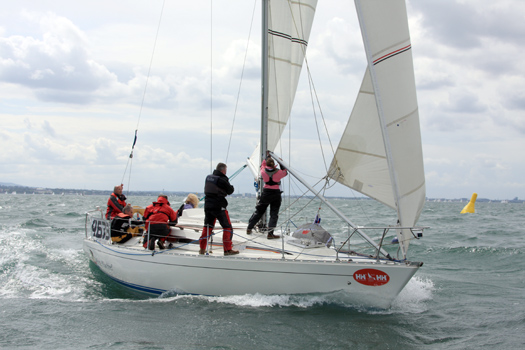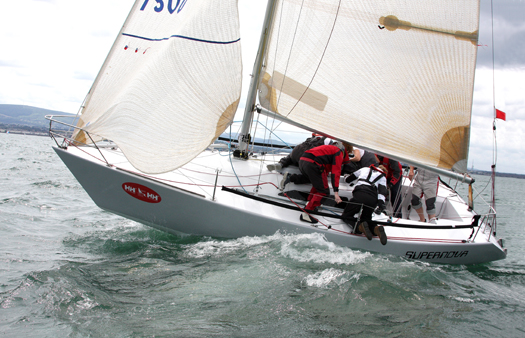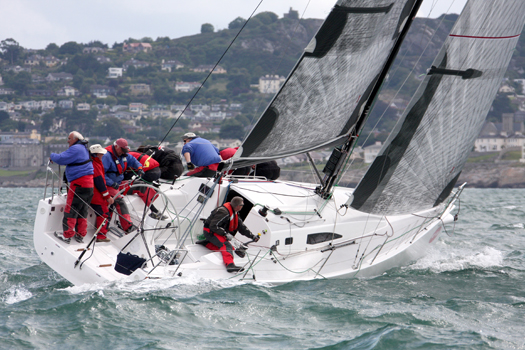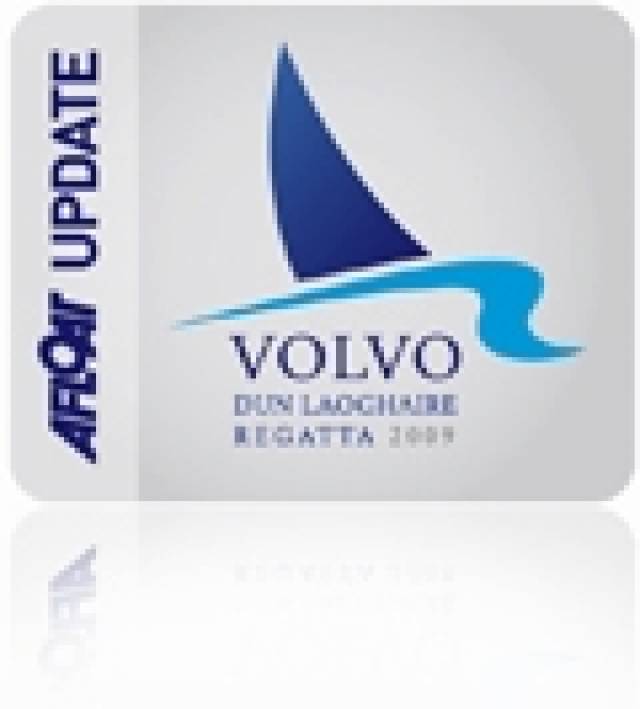Unexpected strong winds got the fourth Volvo Dun Laoghaire Regatta off to a stunning start on Dublin Bay yesterday even though a number of boats in the massive 420-boat fleet got into difficulties as the southerly breeze hit 25 knots. SCROLL DOWN FOR VIDEO AND PICTURES AT THE BOTTOM OF THIS STORY.
Nearly 3,000 sailors and 420 boats are afloat for the four day regatta that is the biggest sailing event in the Irish Sea area.
An impressive line up of 14 Class Zero boats has made Volvo Dun Laoghaire regatta the biggest turnout this year for the 40-footers and it was appropriate that Howth's well campaigned Crazy Horse should make the running in the big sea conditions.

Mighty Max, a Prima 38, a visitor to Dublin Bay from Liverpool
The Chambers/Reilly skippered Mills 36 beat Fairlie visitor Christine Murray's Elf too, a Beneteau First 40 on the windward leeward course. Third was another visitor Grand Cru (Jamie McGarry) from the Clyde.

Crazy Horse takes a wave in the first race. Photo: Gareth Craig
Anthony O'Leary put on a David vs Goliath performance in the dramatic opener. Surfing conditions gave his modified 1720 a real chance to show her speed downwind against some boats seemingly twice the size in IRC One.
The gutsy performance would have put the Royal Cork yacht 'Antix Beag' top of the 19-boat fleet except the Cork crew lost their rig. It is still unofficial but Debbie Aitken's Elan 380 Animal from Royal Northern and Clyde Yacht Club is the probable winner. Second is the locally based Sigma 38 Errislannan skippered by Paul Kirwan.
Late last night O'Leary got a new mast through one of the local sailing school's 1720 fleet and thanks to school principal Alistair Rumball the customised 1720 hopes to be back on the water this morning.

A Mermaid dinghy is dismasted in the strong winds
In class two Sligo visitor Ruthless, a Corby 26, sailed by Conor Ronan beat the locally based half tonner Dick Dastardly from the DMYC. Another vintage half tonner, King one, from Howth and skippered by Dave Cullen was third.
Last year's winner of the overall Volvo trophy Flor O'Driscoll is back in contention again. His J24 Hard on Port was the winner of the regatta's biggest fleet taking a win from Ken Lawless's Supernova in the 38-boat class three division.
In the one design divisions there were plenty of familiar names at the top top of the fleets given the testing southerlies that prevailed.

Sigma Supreme - White Mischief prepares for a hoist
Tim Goodbody leads the Sigma 33s, David Gorman the Flying fifteens, Patrick Boardman the Mermaids, Colin Galavan the SB3s, first race winner Ben Duncan did not sail the second race. Pat Kelly's Storm leads the 10 boat J109s who are also racing for national championship honours.

Supernova takes a tack in Class Three
































































